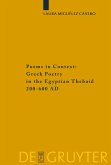Euripides' Danae and Dictys are two of the most important and influential treatments of a popular tragic myth-cycle, which is unrepresented among extant plays. Moreover, they are early treatments of major Euripidean plot-patterns that anticipate and illuminate more familiar works in the corpus, both extant and fragmentary. This is the first full-scale study of the two plays, which sheds light on plot-patterns, key themes and aspects of Euripidean dramatic technique (e.g. his rhetoric, imagery, stagecraft), as well as matters of reception and transmission of both tragedies, by taking into account newly related evidence. The cautious recovery of the two lost plays based on the available evidence and the detailed commentary on their fragments seek to complement our knowledge of Euripidean drama by contributing to an overview and more comprehensive picture of the dramatist's technique, as the extant corpus represents only a small portion of his oeuvre.
Euripides' Danae und Diktys sind zwei der wichtigsten und einflussreichsten Bearbeitungen eines beliebten tragischen Mythenzyklus, der aber unter den erhaltenen Theaterstücken nicht mehr vertreten ist. Als frühe Beispiele für wichtige euripideische Bearbeitungsmuster weisen sie auf einige bekanntere Werke des Corpus, sowohl erhaltene als auch fragmentarische, voraus und erhellen sie. Die vorliegende Arbeit ist die erste umfassende Untersuchung dieser beiden Theaterstücke. Unter Berücksichtigung der neuesten Forschungsergebnisse erklärt sie Bearbeitungsmuster, Schlüsselthemen und -aspekte von Euripides' Bühnenkunst (z. B. Rhetorik, Bilderwelt, Bühnentechnik), und behandelt Fragen zur Rezeption und Überlieferung beider Tragödien. Die behutsame Rekonstruktion der beiden verlorengegangenen Stücke, welche auf dem vorhandenen Beweismaterial aufbaut, und der ausführliche Kommentar zu den Fragmenten versuchen unsere Kenntnisse des Theaters von Euripides zu ergänzen. Es wird ein Beitrag zu einem erweiterten und vollständigeren Bild seiner dramaturgischen Methoden geleistet, da ja das Erhaltene nur einen geringen Teil des Gesamtwerkes ausmacht.
Euripides' Danae und Diktys sind zwei der wichtigsten und einflussreichsten Bearbeitungen eines beliebten tragischen Mythenzyklus, der aber unter den erhaltenen Theaterstücken nicht mehr vertreten ist. Als frühe Beispiele für wichtige euripideische Bearbeitungsmuster weisen sie auf einige bekanntere Werke des Corpus, sowohl erhaltene als auch fragmentarische, voraus und erhellen sie. Die vorliegende Arbeit ist die erste umfassende Untersuchung dieser beiden Theaterstücke. Unter Berücksichtigung der neuesten Forschungsergebnisse erklärt sie Bearbeitungsmuster, Schlüsselthemen und -aspekte von Euripides' Bühnenkunst (z. B. Rhetorik, Bilderwelt, Bühnentechnik), und behandelt Fragen zur Rezeption und Überlieferung beider Tragödien. Die behutsame Rekonstruktion der beiden verlorengegangenen Stücke, welche auf dem vorhandenen Beweismaterial aufbaut, und der ausführliche Kommentar zu den Fragmenten versuchen unsere Kenntnisse des Theaters von Euripides zu ergänzen. Es wird ein Beitrag zu einem erweiterten und vollständigeren Bild seiner dramaturgischen Methoden geleistet, da ja das Erhaltene nur einen geringen Teil des Gesamtwerkes ausmacht.
"Mit dem Reichtum des vorgelegten Materials und dessen wohlüberlegten, abgewogenen Beurteilung hat [die Autorin] ein hervorragendes Arbeitsmittel geschaffen, das nicht so schnell ersetzt werden wird und als ein methodisches Exempel für vergleichbare Arbeiten betrachtet werden darf."Egert Pöhlmann in: Anzeiger für Altertumswissenschaft 1-2/2010 "Ce beau livre termine par une très copieuse bibliographie et par plusieurs index."In: L'Antiquite Classique 2007








